Summary
The problem of understanding the effect of dislocations on the diffraction of X-rays still remains largely unresolved. The treatments byWilson (1) andSuzuki andWillis (2) have not been verified experimentally. However it is possible to show that the line profile derived from an exact treatment is qualitatively in agreement with that obtained by the Stokes-Wilson approximation (4). The approximate treatment can be extended to the case of an edge dislocation. When this is done, it is found that the «tail» of the line profile is not dependent on the dislocation type or orientation. It is also possible to show that the integral breadth, which is also obtained with the approximate treatment, is strongly dependent on the boundary conditions assumed for the cylindrical crystal. Consequently, the results obtained from a consideration of a single isolated dislocation would not appear applicable to an aggregate of dislocations in a real crystal.
Riassunto
Il problema di comprendere l’effetto delle dislocazioni sulla diffrazione dei raggi X è ancora largamente insoluto. Le trattazioni diWilson (1),Suzuki eWillis (2) non sono state verifieate sperimentalmente. È tuttavia possibile dimostrare che il profilo lineare dedotto da una precisa trattazione, è in accordo, qualitativamente, con quella ricavata dalla approssimazione di Stokes-Wilson (4). La trattazione approssimata si può estendere al caso di una dislocazione «edge». Fatto ciò, si trova che la coda del profilo lineare non dipende dal tipo di dislocazione nè dalla orientazione. È pure possibile dimostrare che la larghezza integrale, che si ottiene anche con la trattazione approssimata, è strettamente dipendente dalle condizioni al contorno, assunte per il cristallo cilindrico. Di conseguenza, i risultati ottenuti considerando una singola dislocazione isolata, sembrerebbero applicabili a un aggregato di dislocazioni in un cristallo reale.
Similar content being viewed by others
References
A. J. C. Wilson:Acta Cryst.,5, 318 (1952).
T. Suzuki andB. T. M. Willis:Nature,177, 712 (1956).
A. J. C. Wilson:Nuovo Cimento,1, 277 (1955).
A. R. Stokes andA. J. C. Wilson:Proc. Phys. Soc. London,56, 174 (1944).
F. L. Frank:Research Lond.,2, 542 (1949).
W. T. Read jr.:Dislocation in Crystals (New York, 1953).
This result is qualitatively in agreement with that ofSuzuki andWillis (op. cit.) who report that the (h 01) reflection is both broader and weaker than the (0k1) reflection.
J. F. Nye:Acta Met.,1, 153 (1953).
Author information
Authors and Affiliations
Rights and permissions
About this article
Cite this article
Vassamillet, L.F. Dislocations and their effect on X-ray diffraction. Nuovo Cim 13, 1133–1142 (1959). https://doi.org/10.1007/BF02725124
Received:
Published:
Issue Date:
DOI: https://doi.org/10.1007/BF02725124




